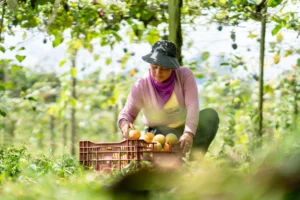This blog post was written by FLPC advanced clinic student Nomin-Erdene Jagdagdorj, JD Candidate 2021
When fellow FLPC student clinician, Jordan, and I landed in Lima, Peru for our Global Food Donation Policy Atlas site visit, we didn’t know exactly what to expect; but that didn’t stop us from having high expectations. As it turned out, our positive anticipation was warranted: over the course of the next four days, we had the opportunity to meet with high-level members of government, grocers, wholesalers, and other stakeholders, all of whom are actively working to promote food donation in Peru.
One of the highlights of the visit was our early morning trek to the wholesale produce market to see food donation in action. Banco de Alimentos del Perú (BAP), with support from Global Foodbanking Network (GFN), recently launched a new program at the market, one which promotes the recovery of surplus fruits and vegetables that are fresh, nutritious, and safe for human consumption. The operation at the wholesale produce market is a major supporter of food security in Lima, but it is also a driver of food waste. Without BAP’s rescue efforts, surplus produce is tossed in the garbage and sent to the landfill to make room for the next day’s offerings.
As we walked around this major supply source food (and food waste), a few aspects struck us as particularly noteworthy:
First—the scale. The market featured several warehouses, each designated for one or two individual vegetables, and divided into dozens of stalls. Piles of sweet potatoes, onions, tomatoes, purple corn, garlic, yucca, pepper filled each stall. With such massive quantities and so many vendors, finding sufficient demand for the supply seemed impossible. It was therefore easy to see the importance of BAP’s surplus recovery operation. Even so, BAP volunteers were able to rescue only a tiny percentage of the surplus produce that is still safe for human consumption. The rest of the unsold product would be discarded into waste bins by the end of the day.
Second —the donors. Starting at midnight, waves of restaurateurs and smaller produce markets had journeyed to the market to stock up on produce. By the time we arrived around 9am, vendors had already started to close down their stalls. Lucky for us, several of BAP’s most regular donors were still around, and we were able to learn about how important it is for many of them to donate their surplus rather than throw it away. Several vendors we interviewed were also producers and did not want to see their hard-earned products simply thrown in the trash because there wasn’t an interested customer. Many vendors went out of their way to make sure that BAP came to pick their leftover produce up multiple times each day, even though it would have been easier to throw away the produce in the trash bins sitting in every aisle. It was refreshing to see that, even when throwing food away seems like the simplest option, people are willing to take the initiative and the time to donate.
Finally, the best surprise—the potential for BAP’s operations at the market to continue its exponential growth. Since July of 2019, when BAP first started recovering produce at the wholesale market, the monthly recovery yield had increased from 20-30 tons to over 127 tons in December alone. BAP had already recovered 32 tons in the first eight days of 2020, even with slow donations through the holidays. Each day, members from five or more charities came to pick up the produce that BAP recovered from the market’s vendors. These charities would transport the food back to their facilities where the food would directly benefit those in need. With no shortage of food surplus as the market, and high rates of food insecurity among Peruvians, we realized that there was tremendous potential for this operation to grow. To make the most of this recovery effort, however, BAP and receiving charities will need much greater operational and financial support.
Seeing the scale of produce available at the market, the willingness of many vendors to donate, and the potential for BAP’s operations to grow were research points we couldn’t have collected in Cambridge. Vendors’ historical practice and continued ease of putting surplus into trash bins remains an obstacle for BAP’s rescue efforts, especially as BAP has limited on-the-ground support and depends entirely on volunteers. Even so, the model at the wholesale market was an impactful example of how food recovery organizations can help redirect fresh, nutritious produce from landfills to those who need it most.
We are so grateful to our food banking partners at BAP and GFN for making our site visit to Peru so informative and meaningful!
The views reflected in this blog are those of the individual authors and do not necessarily represent those of the Center for Health Law & Policy Innovation or Harvard Law School. This blog is solely informational in nature, and not intended as a substitute for competent legal advice from a licensed and retained attorney in your state or country.


Food Law & Policy, Commentary
Policy to Reduce Methane Emissions and Feed More People
April 3, 2025